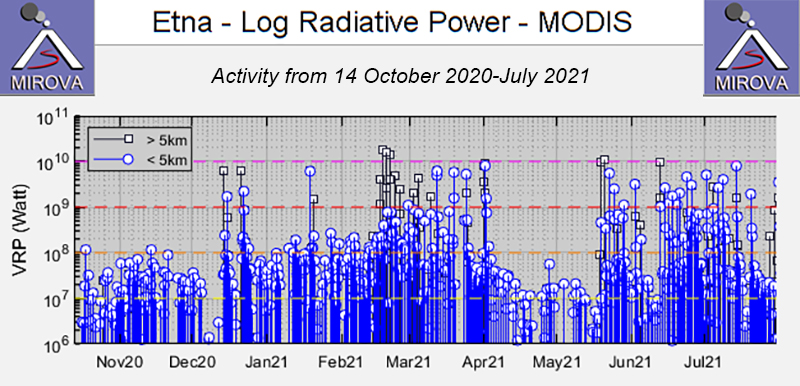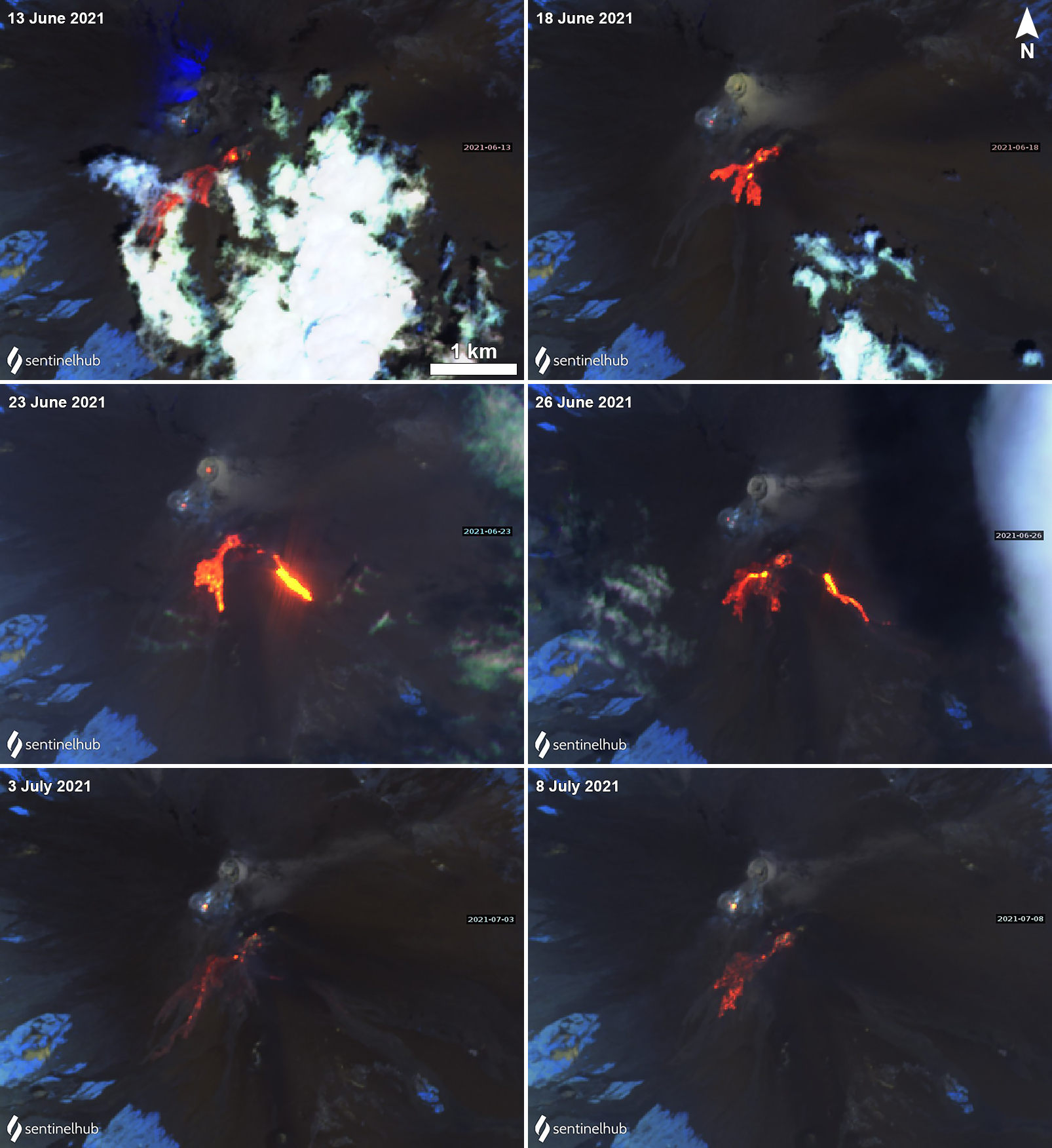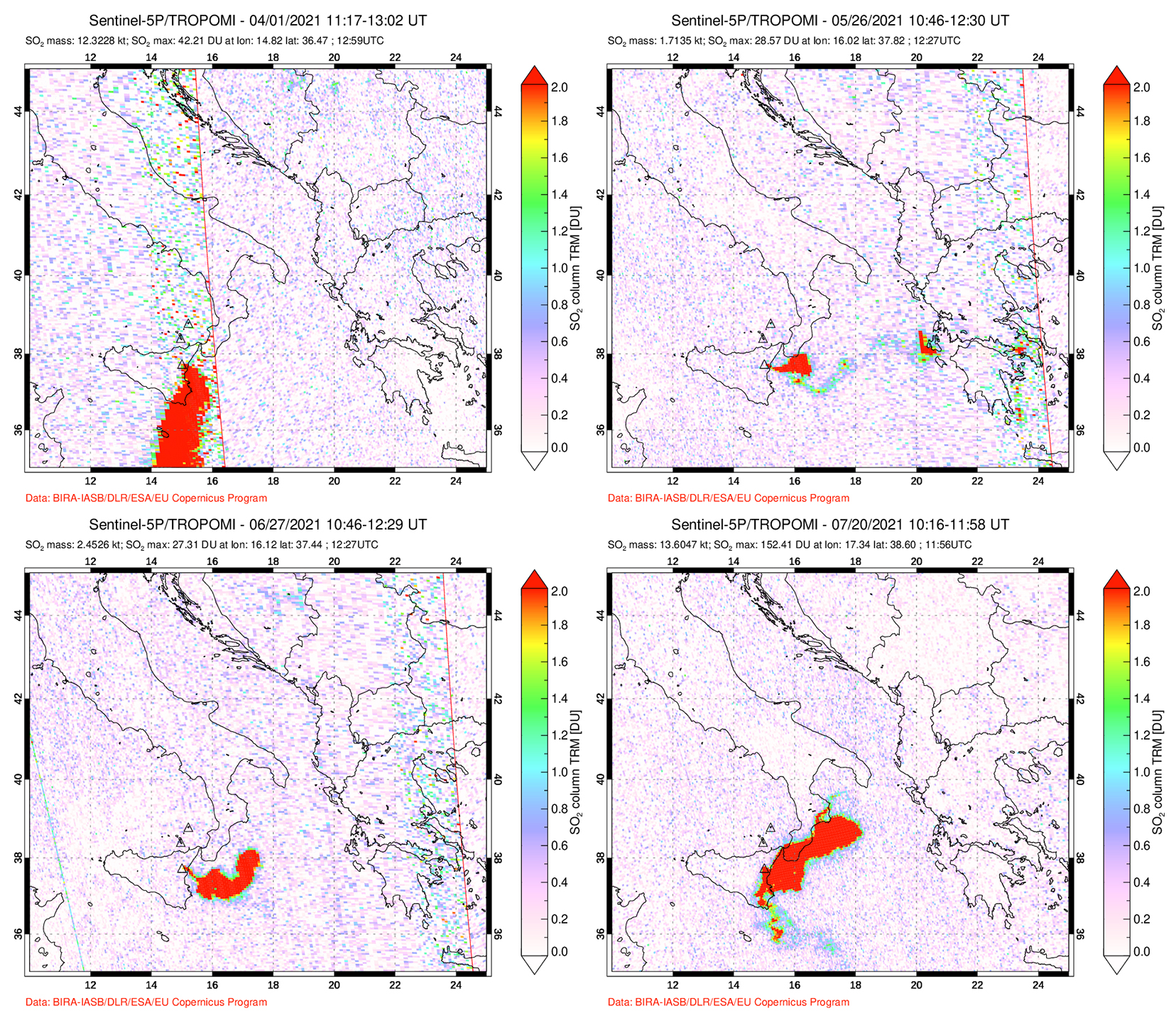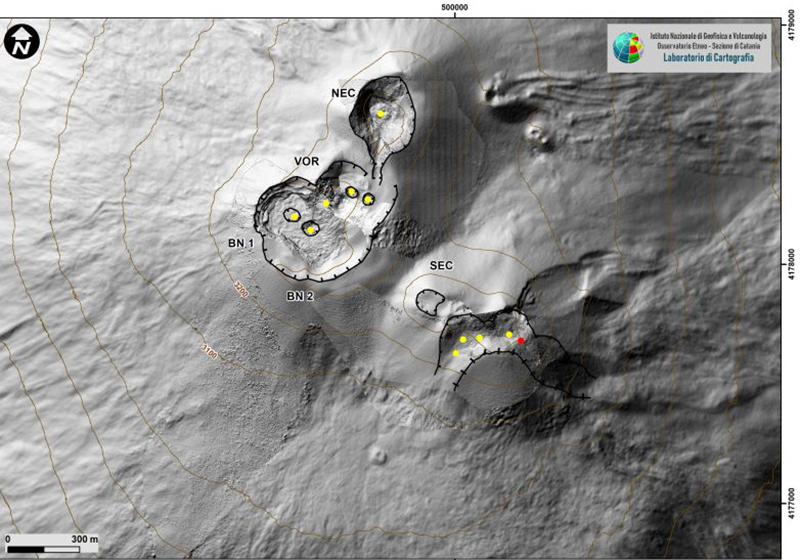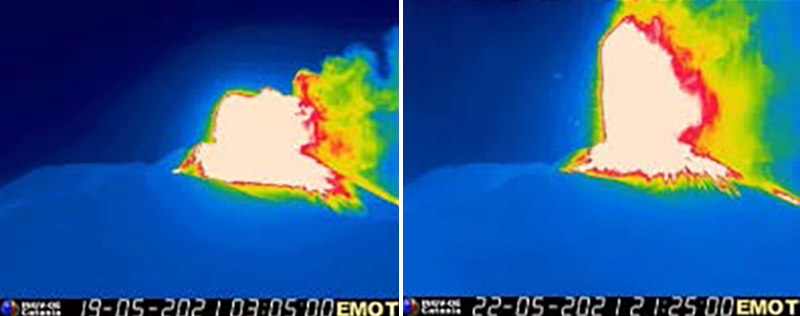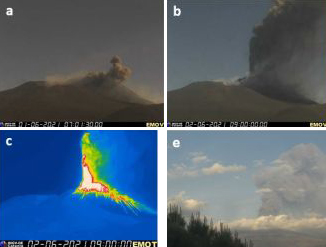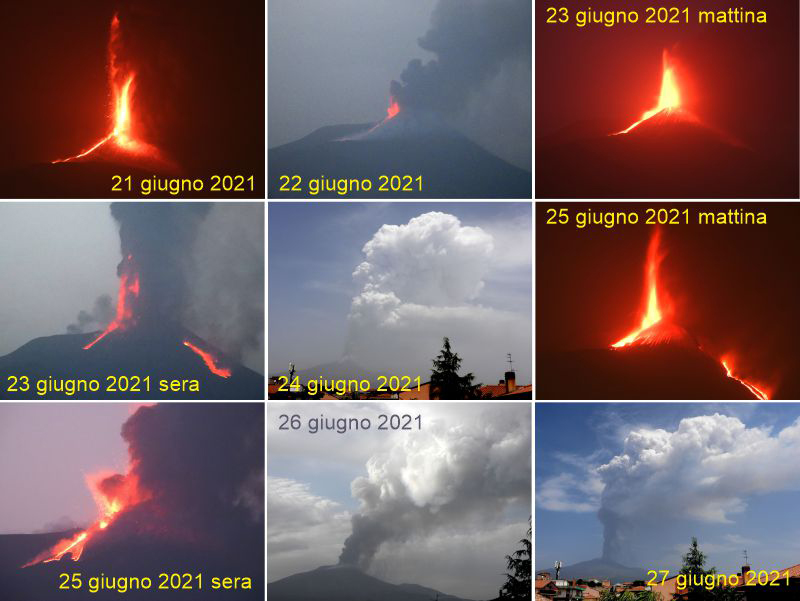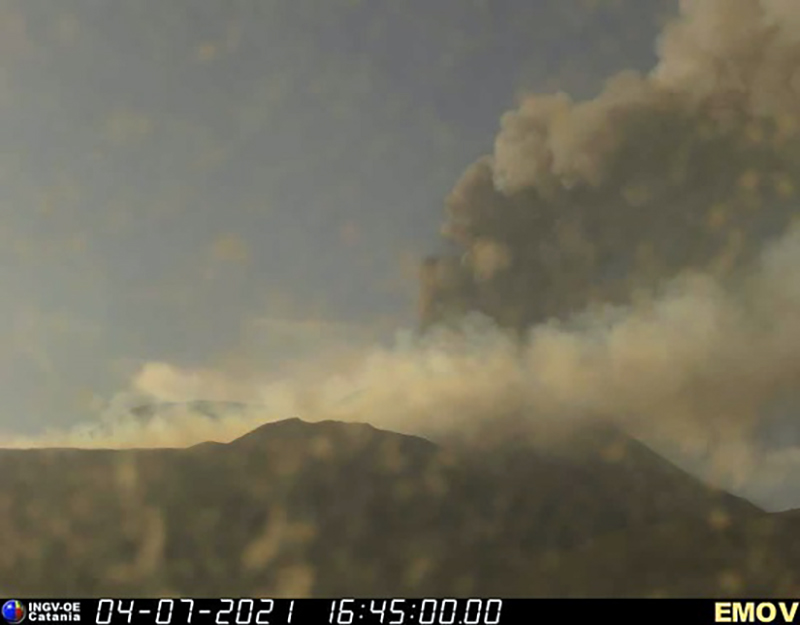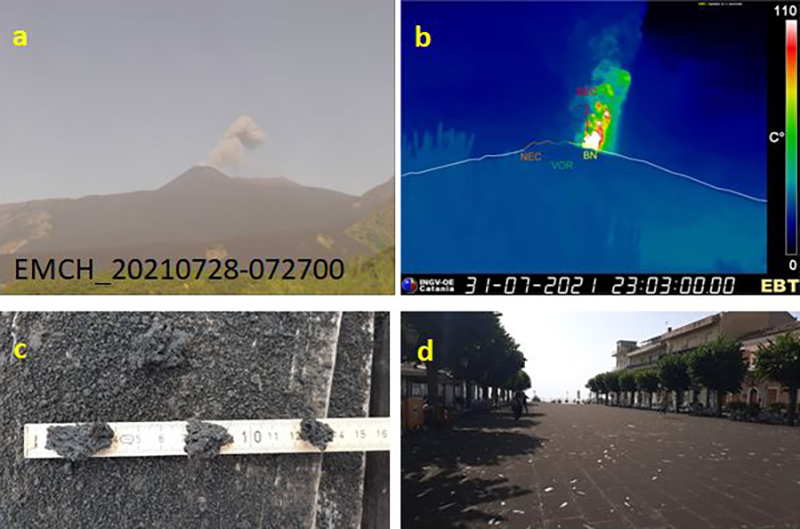Report on Etna (Italy) — August 2021
Bulletin of the Global Volcanism Network, vol. 46, no. 8 (August 2021)
Managing Editor: Edward Venzke.
Edited by Kadie L. Bennis.
Etna (Italy) Strombolian explosions, ash plumes, lava fountaining, and flows during April-July 2021
Please cite this report as:
Global Volcanism Program, 2021. Report on Etna (Italy) (Bennis, K.L., and Venzke, E., eds.). Bulletin of the Global Volcanism Network, 46:8. Smithsonian Institution. https://doi.org/10.5479/si.GVP.BGVN202108-211060
Etna
Italy
37.748°N, 14.999°E; summit elev. 3357 m
All times are local (unless otherwise noted)
Etna, located on the island of Sicily, Italy, has documented records of historical eruptions dating back to 1500 BCE. Activity has frequently originated from its summit areas, which include the Northeast Crater (NEC), the Voragine-Bocca Nuova (or Central) complex (VOR-BN), the Southeast Crater (SEC, formed in 1978), and the New Southeast Crater (NSEC, formed in 2011). Another crater, referred to as the "cono della sella" (saddle cone), developed during early 2017 between SEC and NSEC. Its most recent eruptive period began in September 2013 and more recently has been characterized by Strombolian explosions, ash plumes, lava fountaining, and flows (BGVN 46:04). This report updates activity from April through July 2021, covering similar eruptive events, based on weekly and special reports by the Osservatorio Etneo (OE), part of the Catania Branch of Italy's Istituo Nazionale di Geofisica e Vulcanologica (INGV) and satellite data.
Summary of activity during April-July 2021. Volcanism was relatively low at Etna during April and mid-May, primarily characterized by Strombolian explosions and white gas-and-steam emissions. Beginning on 19 May 2021, activity intensified and remained high through July. Intra-crater Strombolian explosions varied in intensity and frequency dominantly in the Southeast Crater (SEC), accompanied by ash plumes that rose to a maximum altitude of 10 km, resulting in ashfall in nearby communities, lava flows primarily on the SW flank, and lava fountains that rose up to 1 km above the summit. Occasional isolated ash emissions were observed above the Northeast Crater (NEC) while degassing primarily characterized the Bocca Nuova Crater (BN) and the Voragine Crater (VOR).
MIROVA (Middle InfraRed Observation of Volcanic Activity) analysis of MODIS satellite data shows strong and frequent thermal anomalies during a majority of the reporting period; during April through mid-May there was a notable decline in the intensity of the anomalies, which was followed by a significant strong pulse, representing the lava flows in June and July (figure 340). This stronger thermal activity was also reflected in data from the MODVOLC thermal algorithm, a total of 183 alerts were detected in the summit crater during April through July; thermal anomalies were reported for four days in April, nine days in May, sixteen days in June, and twelve days in July. Additionally, the lava flows were clearly visible in Sentinel-2 infrared satellite imagery during June and July descending the SW and SE flanks from SEC (figure 341). Frequent Strombolian activity contributed to distinct sulfur dioxide plumes that exceeded two Dobson Units (DUs) that drifted generally S and E (figure 342).
Activity during April 2021. During April, INGV reported intra-crater Strombolian explosions in NEC, BN, and SEC. On 1 April around 0100 the SEC explosions transitioned into lava fountaining, generating an ash plume at 0940 that rose to 9 km altitude and drifted SSW. At 0200 a lava flow was reported in the eastern edge of SEC, moving toward the upper part of the VOR-BN complex (Valle del Bove) over the older flows that appeared during March 2021. By 1000 the fountaining had stopped, though explosions continued, producing ash plumes that rose to 5.5-9 km altitude and drifted S and SSW. As a result, ashfall was reported in Milia, Nicolosi, and Catania, and lapilli up to 1 cm was reported in Rifugio Sapienza. A second lava flow appeared at 1040, originating from the same eastern vent and migrating toward VOR-BN. Explosivity gradually declined around 1320 in SEC; by 2300 the lava flows had begun to cool and explosions were no longer observed in the summit crater. During the rest of the month volcanism was relatively low, though intra-crater Strombolian explosions continued in NEC and BN; degassing was prominent in SEC, VOR-BN, and NEC craters. Explosions would eject material tens of meters above the crater rim in NEC, accompanied by some ash emissions. At VOR-BN, an overflight on 13 April noted that activity was focused in the western vents, ejecting reddish ash emissions. An explosion in the eastern vent in SEC at 0030 on 25 April ejected incandescent material 350 m above the crater rim; an ash plume was visible drifting S.
Activity during May 2021. Activity during the first half of May remained similar to the previous month, with degassing at the summit craters and weak, intermittent Strombolian explosions occurring at the eastern vents in SEC, accompanied by ash emissions (figure 343). During the second week of May, INGV reported isolated ash emissions from NEC. On 19 May at 0221 the Strombolian activity in SEC intensified, accompanied by ash emissions, which evolved into lava fountaining by 0234 (figure 344). At the same time, a lava flow was observed traveling down the SW flank, reaching an elevation of 2.8 km. This event lasted three and a half hours, after which the fountains and explosions stopped abruptly. The lava flow was 1.8 km long, 1.5 m thick, and had a volume of 450,000 m3. On 22 May at 0134 Strombolian explosions continued in SEC, generating ash plumes that drifted SE. By 0302 the explosions evolved into lava fountains that ejected material to the NE. A second lava flow developed on the SW flank, overlapping the one from the 19th, advancing to 3 km elevation. It was 1 km long, 1.5 m thick, and had a volume of 150,000 m3. A third lava flow was observed on the E flank was 0.5 km long, 1.5 m thick, and a volume of 70,000 m3. At 0454 the lava fountain and explosive activity had stopped abruptly.
On 24 May explosions were accompanied by a lava flow on the SW flank that descended to 900 m elevation, was 1.5 m thick, and had an erupted volume of 150,000 m3. The most intense phase of the explosions occurred during 2235 and 2345; activity ended around 0010. On 25 May an ash plume rose to 4 km altitude and drifted ENE at 1020; by 1820 explosive activity resumed. Two eruptive episodes on 26 May with peaks at 0350 and 1300 resulted in fine ashfall in Milo (10 km E). The next day, explosions intensified in SEC at 1450 while tephra fell in Giarre (17 km ESE), Milo, and Fornazzo (10 km ESE), though inclement weather prevents visual observations. On 28 May three explosive events were detected beginning at 0830, reaching a maximum intensity at 0900, and ending at 0930. As a result, ashfall was reported in Giarre. A second explosive episode occurred during 1740 and 1815 and a third, more intense explosive episode occurred during 2115-2350. On 30 May explosions beginning at 0545 lasted for two hours and resulted in fine ashfall in Petrulli (12 km SE).
Activity during June 2021. Variable Strombolian activity persisted during June, mainly in SEC; minor and diffuse ash emissions occurred at BN and ash emissions were reported on 4 June in NEC. Degassing was reported in BN and VOR. Weak Strombolian activity in SEC began at 0850 on 2 June, producing minor and diffuse ash plumes, which intensified around 1000 and transitioned to lava fountains that lasted more than two hours (figure 345). The lava fountains generated ash plumes that rose to 5-6 km altitude and drifted E, resulting in ashfall N of Zafferana, near Petrulli and Santa Venerina (figure 345). A lava flow was observed on the S flank of SEC that traveled SW. Fountains stopped at 1245. During the night and early morning of 3-4 June weak intra-crater explosions continued. On 4 June activity increased at 1530 and was characterized by discontinuous ash emissions and a lava flow descending the S flank of SEC. Lava fountains began at 1820 and generated an ash plume that rose to 6.5 km altitude and drifted SE. Ejecta was deposited in Aci Castello, Aciterzza, San Giovanni, La Punta, Tremestieri, Catania, Viagrande, and between Pedara, Fleri, and Siracusa. By 1930 the fountaining had stopped; webcam images showed that by 2300 the lava flow remained active at an elevation of 2.8 km and was a thickness of 2 m.
On 9 June at 0110 intra-crater Strombolian activity was reported in the saddle cone, accompanied by discontinuous ash emissions, which continued through 11 June. Coarse material was ejected tens of meters from the edge of SEC, falling back into the crater. The lava flow descending the SW flank on 12 June reached an elevation of 2.7 km and was 1.7 km long, 1.5 m thick, and had a volume of 700,000 m3. At 2130 explosions transitioned into lava fountains that rose 400-500 m above the crater and produced an ash plume that rose to 5.5 km altitude and drifted SSE. Ashfall was reported in Sapienza, Refuge, Nicolosi, Tremestieri, Belpasso, and Catania. The fountains ended at 2350, alongside a cooling flow on the SW flank, though Strombolian explosions continued in SEC.
Several lava fountaining episodes were reported during 1332-1450 on 16 June, 2220 on 18 June to 0210 on 19 June, 2040-2215 on 19 June, 1131 on 20 June to 0214 on 21 June, overnight during 21-22 June, and during the early hours of 22 and 23 June. Each episode began with Strombolian explosions, followed by fountaining and crater overflows descending the SW and SE flanks toward the Valle del Bove (S) on 16 June while those on 21 June traveled 1 km SW toward Monte Frumento Supino, stopping at 2.9 km elevation (figure 341). Ash plumes rose as high as 8 km altitude, causing ashfall the S and SSE. INGV reported nine lava fountain episodes at SEC occurred during 21-27 June; explosive activity was concentrated in the W part of SEC at three of the four saddle vents, though some weak, isolated explosions were detected in the E vents (figure 346). The episodes generated ash plumes rising 5-10 km altitude while lava flows descended the SW and SE flanks (figure 346). An effusive vent was detected on the SE flank of SEC on 23 June. The lava fountaining events have caused SEC cone to grow significantly.
Activity during July 2021. Strombolian activity, lava fountains, and ash plumes from SEC continued in July, in addition to occasional gas-and-ash emissions in NEC and BN. Three episodes of lava fountains generated ash plumes that rose 5-10 km altitude, resulting in ashfall to the E and SE. The first episode occurred at SEC at 0040 on 2 July, beginning with Strombolian explosions. Resulting ash plumes drifted ESE and within an hour, lava fountains were visible, accompanied by lava flows moving SW; fountaining had stopped at 0250. The second episode began at 1656 on 4 July, producing fountains at 1725 and ash plumes, ending by 1900 (figure 347). Lava flows traveled SW and ENE while the ash plumes drifted ESE. The last episode occurred at 2330 on 6 July; ash plumes rose to 5 km altitude and drifted SE; ash deposits were observed on the S flank. Explosions intensified at 0000 on 7 July with fountaining occurring thirty minutes later, rising as high as 1 km. A small lava flow originated from the S side of the cone and traveled SW, reaching an elevation of 2.8 km.
During fieldwork on 7 July scientists observed bombs up to 1 m in diameter on the N side of Mount Barbagallo, while smaller bombs were observed farther away. Lapilli was reported in the S part of Tremestieri, and ash was deposited in Nicolosi, as well as other communities downwind. This episode lasted about two hours. A second episode that began at 2100 on 8 July consisted of Strombolian activity and lava fountains. Ash plumes rose to 3.4 km altitude and drifted SE, resulting in ashfall and the front of the lava flow reached 2.4 km elevation. On 14 July explosions generated an ash plume that rose to 9 km altitude and drifted NE, which resulted in 1-cm-thick lapilli and ash deposits in the Rocca Campana district, as well as in the Rifugio, Citelli, and Presa, with ashfall in Taormina and the S part of Calabria. Another lava flow on the S flank of SEC was moving SW and had begun to cool by 15 July.
On 20 July at 0150 explosions in SEC generated ash emissions that drifted SSE; at 0650 the intensity of these explosions increased and eventually evolved into lava fountains at 0920. At the same time, a lava flow along the side of the SW flank of SEC was reported, as well as deposits of material on the S and E flanks of the volcano. Two lava flows moving SW were detected on the N flank of SEC, stopping at an elevation of 2.9 km. An ash plume drifted E and resulted in ashfall on the E flank and in Zafferana, Milo, and Fornazzo. On 26 July INGV reported continuous ash emissions at NEC that rose to 6 km altitude and drifted N. Strombolian activity intensified again at 0925 on 28 July in SEC, generating discontinuous ash emissions (figure 348); this episode stopped by 2318. Explosions in SEC began again at 1915 on 31 July, producing ash plumes that rose to 5 km altitude and drifted SE, resulting in ashfall in Fornazzo and Milo. At 2115 a lava flow down the SW flank reached 2.8 km elevation.
Geological Summary. Mount Etna, towering above Catania on the island of Sicily, has one of the world's longest documented records of volcanism, dating back to 1500 BCE. Historical lava flows of basaltic composition cover much of the surface of this massive volcano, whose edifice is the highest and most voluminous in Italy. The Mongibello stratovolcano, truncated by several small calderas, was constructed during the late Pleistocene and Holocene over an older shield volcano. The most prominent morphological feature of Etna is the Valle del Bove, a 5 x 10 km caldera open to the east. Two styles of eruptive activity typically occur, sometimes simultaneously. Persistent explosive eruptions, sometimes with minor lava emissions, take place from one or more summit craters. Flank vents, typically with higher effusion rates, are less frequently active and originate from fissures that open progressively downward from near the summit (usually accompanied by Strombolian eruptions at the upper end). Cinder cones are commonly constructed over the vents of lower-flank lava flows. Lava flows extend to the foot of the volcano on all sides and have reached the sea over a broad area on the SE flank.
Information Contacts: Sezione di Catania - Osservatorio Etneo, Istituto Nazionale di Geofisica e Vulcanologia (INGV), Sezione di Catania, Piazza Roma 2, 95123 Catania, Italy (URL: http://www.ct.ingv.it/it/ ); MIROVA (Middle InfraRed Observation of Volcanic Activity), a collaborative project between the Universities of Turin and Florence (Italy) supported by the Centre for Volcanic Risk of the Italian Civil Protection Department (URL: http://www.mirovaweb.it/); Hawai'i Institute of Geophysics and Planetology (HIGP) - MODVOLC Thermal Alerts System, School of Ocean and Earth Science and Technology (SOEST), Univ. of Hawai'i, 2525 Correa Road, Honolulu, HI 96822, USA (URL: http://modis.higp.hawaii.edu/); NASA Global Sulfur Dioxide Monitoring Page, Atmospheric Chemistry and Dynamics Laboratory, NASA Goddard Space Flight Center (NASA/GSFC), 8800 Greenbelt Road, Goddard, Maryland, USA (URL: https://so2.gsfc.nasa.gov/); Sentinel Hub Playground (URL: https://www.sentinel-hub.com/explore/sentinel-playground).


